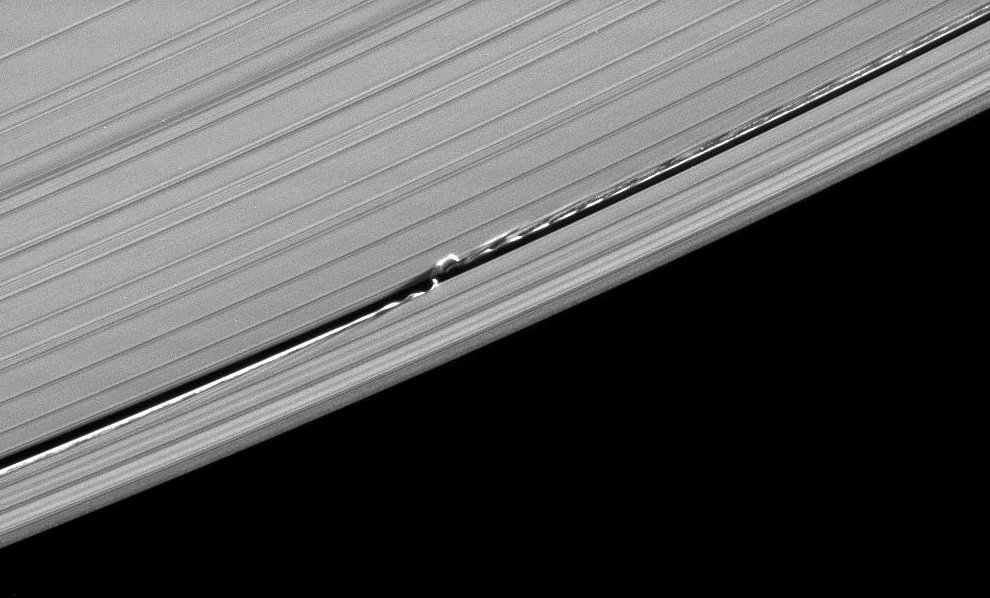 "Another view of waves in the edges of the Keeler gap in Saturn's A ring, created by the embedded moon Daphnis." Like most objects in the solar system, Saturn and its ring particles rotate in a right-hand sense; point your right thumb up, and the direction your fingers point and curl represent what is meant by "right-handed rotation." Ring particles closer to Saturn orbit more quickly, and farther out, more slowly. The gravitational disruption caused by Daphnis, seen as waves, would not be visible without the very low angle lighting conditions casting shadows. The inner ring particles are orbiting more quickly than Daphnis, so the waves appear to be propagating left to right. The outer ring is orbiting more slowly, so the disruption appears to be moving right to left.
"Another view of waves in the edges of the Keeler gap in Saturn's A ring, created by the embedded moon Daphnis." Like most objects in the solar system, Saturn and its ring particles rotate in a right-hand sense; point your right thumb up, and the direction your fingers point and curl represent what is meant by "right-handed rotation." Ring particles closer to Saturn orbit more quickly, and farther out, more slowly. The gravitational disruption caused by Daphnis, seen as waves, would not be visible without the very low angle lighting conditions casting shadows. The inner ring particles are orbiting more quickly than Daphnis, so the waves appear to be propagating left to right. The outer ring is orbiting more slowly, so the disruption appears to be moving right to left.Awesome and beautiful.
The Planetary Society Blog points out a mysterious trap door on the lunar surface...
 Higher resolution:
Higher resolution: It is thought that this may be a skylight in a basaltic lava tube. When a highly fluid lava like basalt erupts, the outer margins, including the upper surface, cool and solidify first. This outer crust insulates the interior, and allows it to stay hot and flowing longer. Often, after the source eruption ceases, the lava partially or completely drains, and leaves an empty tube behind. On occasion, a part of the roof collapses, leaving a hole through the roof into the tube, as seen below:
It is thought that this may be a skylight in a basaltic lava tube. When a highly fluid lava like basalt erupts, the outer margins, including the upper surface, cool and solidify first. This outer crust insulates the interior, and allows it to stay hot and flowing longer. Often, after the source eruption ceases, the lava partially or completely drains, and leaves an empty tube behind. On occasion, a part of the roof collapses, leaving a hole through the roof into the tube, as seen below: The above and following were swiped from Facebook friend Kevin's page, and were taken at Derrick Cave in Central Oregon. The most common type of lava tube entrance is a complete collapse of the roof and walls of the tube. The picture below is looking from inside the main part of the cave (there's a smaller segment on the opposite side of the opening) to the outdoors.
The above and following were swiped from Facebook friend Kevin's page, and were taken at Derrick Cave in Central Oregon. The most common type of lava tube entrance is a complete collapse of the roof and walls of the tube. The picture below is looking from inside the main part of the cave (there's a smaller segment on the opposite side of the opening) to the outdoors. So this is the terrestrial equivalent of what we appear to have found on the moon. As the Planetary Society post points out, this could be an ideal site for a base, providing shelter both from ionizing radiation, and from extreme heat and cold through the course of a lunar day. There is a certain irony that, as we look at what may be the human frontier over the next century, we hark back thousands of years, seeking caves for shelter.
So this is the terrestrial equivalent of what we appear to have found on the moon. As the Planetary Society post points out, this could be an ideal site for a base, providing shelter both from ionizing radiation, and from extreme heat and cold through the course of a lunar day. There is a certain irony that, as we look at what may be the human frontier over the next century, we hark back thousands of years, seeking caves for shelter.I've seen this story in a number of papers; this excerpt is from the NYT coverage:
European astronomers have found 32 new planets outside our solar system, adding evidence to the theory that the universe has many places where life could develop. Scientists using the European Southern Observatory telescope didn't find any planets quite the size of Earth or any that seemed habitable or even unusual. But their announcement increased the number of planets discovered outside the solar system to more than 400.Right now, we have two proven methods of planet discovery: spectroscopy and occultation. As a planet orbits its star, the star is also tugged back and forth- remember, for each action, there is an equal but opposite reaction. The star is many times larger than the planet, so its motion is changed by much less, but it is changed. Careful analysis of the star's spectrum over a period of days to years can demonstrate a cyclical shift from bluer to redder and back. If this shift is persistent over two or more cycles, it is taken to be evidence that the star's motion is being perturbed by an orbiting planet. The second method, occultation, is more straightforward. If a planet passes in front of the stellar disk, the amount of light we receive from the star decreases. Again, we look for this signal to repeat two or more times- enough that we feel we can confidently predict the next luminosity decrease. If we can get both spectroscopy and occultation from the same star and planet, we can get at both the volume (derived from radius, related to luminosity decrease) and mass (related to stellar mass and perturbation of the star's motion). Volume and mass allow us to calculate density, which allows us to determine whether the planet is gaseous or rocky. A bit more than a month ago, researchers announced the discovery of the first rocky exoplanet. It's beginning to look like there's a really good chance of finding other earth-like planets.
Finally, The BBC is reporting that a week from today, a test of the new Ares 1-X will be carried out. As I read it, this will be simply a functionality test of the first stage; the upper stages will simply be dummy weights, and while I'm sure everything will be instrumented to the hilt, there will be no passengers. As much as I've enjoyed watching the shuttle flights, I have to admit I'm excited to see the return of the sheer monstrous power of the Saturn V-style rockets.










No comments:
Post a Comment